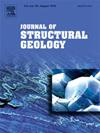Quantitative characterization of fracture network in large sheath-fold: field and UAV-based digital outcrop model analysis (Ligurian Alps, Italy)
IF 2.9
2区 地球科学
Q2 GEOSCIENCES, MULTIDISCIPLINARY
引用次数: 0
Abstract
Predictive models for the origin and distribution of tectonic fractures in regions with multiple and heterogeneous deformation events are still considered as characterized by a high degree of uncertainty. In fact, it is known that fracture networks development is dependent by many factors, such as composition, diagenesis, structural position, fold bending and changes in the tectonic stress history. However, several studies noted that the high-curvature regions of large folds often show a good correlation between the measured and theoretical geometry of the fracture sets. This paper presents a field- and digital outcrop model-based structural investigation of refolded km-scale sheath fold (Caprazoppa fold) and associated fractures host in a metamorphic carbonate sequence (Ligurian Briançonnais, Western Alps) that experienced multiple regional deformation phases. The orientation of the fracture sets along the 3D fold structure are broadly consistent with the network theoretically expected as due by the main sheath fold curvature. The subsequent, less intense ductile phase produced significant change of the structural patterns only in the schistose lithologies, whereas the more competent rocks mostly recycled the early foliations and fracture sets. Even the post-metamorphic brittle faulting/fracturing selectively reactivated the pre-existing fractures favorably oriented. We infer that, when strain is high, the strongly curved sheath folds exert a major control in the development of the fracture network, the geometry of which is preserved through the subsequent ductile/brittle deformation stages.
大型鞘褶皱裂缝网络的定量表征:基于野外和无人机的数字露头模型分析(利古里亚阿尔卑斯山脉,意大利)
在多变形和非均质变形地区,构造裂缝的成因和分布预测模型仍被认为具有高度不确定性。事实上,裂缝网络的发育取决于多种因素,如成分、成岩作用、构造位置、褶皱弯曲以及构造应力史的变化等。然而,一些研究指出,大褶皱的高曲率区域通常在裂缝集的测量几何形状和理论几何形状之间表现出良好的相关性。本文以野外和数字露头模型为基础,研究了西阿尔卑斯利古里亚brianonnais变质碳酸盐岩层序中经历多个区域变形阶段的千米尺度鞘褶皱(Caprazoppa褶皱)及其相关裂缝主。裂缝组沿三维褶皱构造的方向与理论预测的主鞘层褶皱曲率所导致的网络大致一致。随后较弱的韧性阶段只在片岩岩性中产生了明显的构造模式变化,而较强的岩石则主要循环了早期的片理和裂缝组。即使是变质后的脆性断裂/压裂也选择性地激活了已有的裂缝。我们推断,当应变较高时,强烈弯曲的鞘层褶皱对裂缝网络的发展起主要控制作用,其几何形状在随后的韧性/脆性变形阶段得以保留。
本文章由计算机程序翻译,如有差异,请以英文原文为准。
求助全文
约1分钟内获得全文
求助全文
来源期刊

Journal of Structural Geology
地学-地球科学综合
CiteScore
6.00
自引率
19.40%
发文量
192
审稿时长
15.7 weeks
期刊介绍:
The Journal of Structural Geology publishes process-oriented investigations about structural geology using appropriate combinations of analog and digital field data, seismic reflection data, satellite-derived data, geometric analysis, kinematic analysis, laboratory experiments, computer visualizations, and analogue or numerical modelling on all scales. Contributions are encouraged to draw perspectives from rheology, rock mechanics, geophysics,metamorphism, sedimentology, petroleum geology, economic geology, geodynamics, planetary geology, tectonics and neotectonics to provide a more powerful understanding of deformation processes and systems. Given the visual nature of the discipline, supplementary materials that portray the data and analysis in 3-D or quasi 3-D manners, including the use of videos, and/or graphical abstracts can significantly strengthen the impact of contributions.
 求助内容:
求助内容: 应助结果提醒方式:
应助结果提醒方式:


